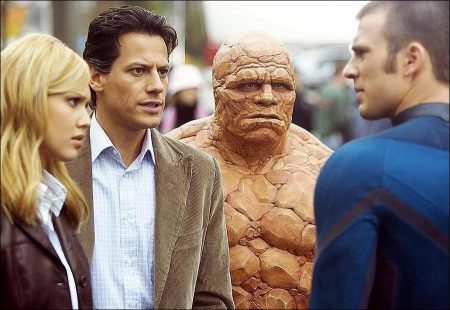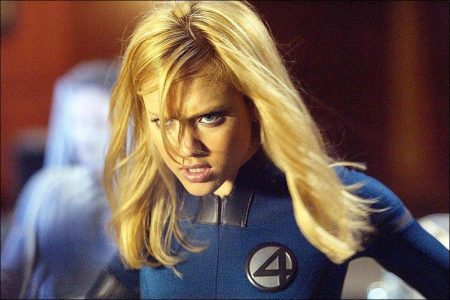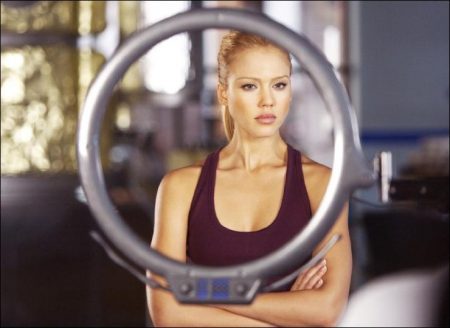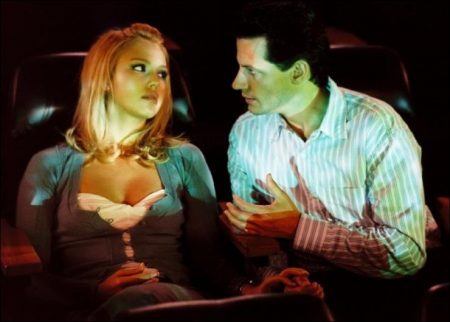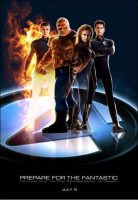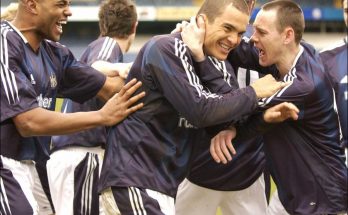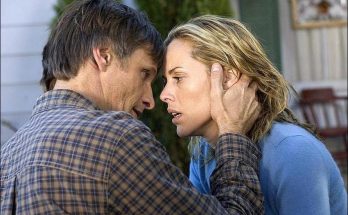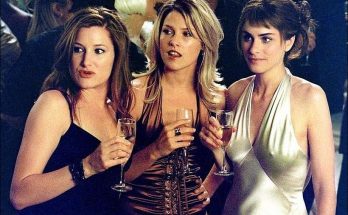Tagline: Astronauts. Superheroes. Celebrities. To the world, they are the Fantastic Four. To each other, they are a family.
Inventor, astronaut and scientist Dr. Reed Richards’ (Ioan Gruffudd) lifelong dream is close to being realized. He is spearheading a trip to outer space, to the center of a cosmic storm. There he hopes to unlock the secrets of the human genetic codes for the benefit of all humanity. Extensive government grant cutbacks nearly dashed the visionary’s hopes of the historic flight, until Reed accepted a financing deal with his old college rival, Victor Von Doom (Julian McMahon), now a billionaire industrialist.
Reed’s crew for the mission includes his best friend, astronaut Ben Grimm (Michael Chiklis); Sue Storm (Jessica Alba), Von Doom’s director of genetic research and Reed’s ex-girlfriend; and Sue’s hot-headed younger brother, pilot Johnny Storm (Chris Evans). With benefactor Von Doom in tow, the four set off for the exploration of a lifetime. The mission is uneventful – until Reed discovers a miscalculation of the speed of the approaching storm. Within minutes, the event threshold is upon them. The space station is engulfed by turbulent clouds of cosmic radiation which genetically transforms the crew. Their DNA is irrevocably altered…and so is their future.
Back on earth, the effects of the exposure are quickly revealed. Reed gains the ability to stretch and contort his body into any shape he can imagine and, as leader of the group, is given the name Mr. Fantastic; Sue is able to render herself invisible and to create and project powerful force fields as Invisible Woman; Johnny becomes known as The Human Torch, as he can now engulf his body in flames and take flight at will; and Ben, whose freakish transmutation is the most shocking, becomes an orange-colored, rock-like, superhumanly strong creature, The Thing.
Together, they turn tragedy into triumph and catastrophe into coalition, using their unique and formidable powers to thwart the evil plans of their now steely-eyed, iron-fisted nemesis Dr. Doom and to protect the citizens of New York City against any threat that may arise.
Fantastic Four is based on Marvel’s longest running comic book series, which has well-earned its moniker as “The Greatest Comic in the World.” While several Marvel comics-to-film adaptations have preceded Fantastic Four, most notably the “X-Men” and “Spider-Man” features, Fantastic Four required, for self-evident reasons, four times the special effects power of any previous comic-to-film epics; indeed, the film’s finalized effects are so groundbreaking that the technology used to create them didn’t even exist a year ago. But for all its state-of-the-art effects, what makes Fantastic Four special is its humor and emotion. The characters are, after all, the superhero world’s most famous dysfunctional family.
The “fantastic” phenomenon began 44 years ago, when Marvel Comics’ publisher Martin Goodman, after playing a round of golf with an industry competitor, decided to move forward with an intriguing idea. Goodman shared it with the legendary comics writer Stan Lee.
“Martin said to me `Why don’t you create a team of superheroes?'” recalls Lee. “So, with Jack Kirby, we created the Fantastic Four and over four decades later it remains the jewel in the Marvel crown.”
Lee wanted his superheroes to be real people without secret identities. “I wanted to create them as if they were real people living amongst us in the real world who just happened to have super powers,” he says. “They are the first family of superheroes, four people who live and work together like a family. We hadn’t seen a relationship like that in the comics prior to Fantastic Four and it made them very unique and very popular among the fans.
For Stan Lee, seeing this comic book come to life is truly a “Marvel-ous” feeling. “It’s thrilling really,” says Lee. “Fox has wanted to make this movie for a long time. I’m glad they waited for the right story and the right technology. They certainly got the perfect cast and it’s all going to be up there on the big silver screen…the humor, the drama, the adventure, the action, the fun…all the things that make them so fantastic.”
The movie adaptation of Marvel’s Fantastic Four comic book was in development for over a decade, as producers like Constantin Films’ Bernd Eichinger and Chris Columbus’ 1492 Productions searched for the right screenplay.
Over a period of years, several writers penned script drafts. Things began to coalesce with Michael France’s (“Hulk”) screenplay. “I’ve wanted to see a big-screen `Fantastic Four’ movie since I was a kid,” says France. “Taking a swing at a `Fantastic Four’ film is one of the reasons I wanted to get into the movies in the first place.”
To France and the producers, the chief goal was capturing the right tone. “The tone direction was to follow the original comics,” says France. “We wanted the film to be thrilling and full of things you’ve never seen in a movie.”
After several other drafts, writer Mark Frost (“Twin Peaks”), also a fan of the Fantastic Four comics, stepped in to continue shaping the script. “I thought we needed to go to the roots of the comics,” says Frost. “I felt that at its core, the story was really very simple. My instinct was that the story for the movie needed be like the earlier comics, by Stan Lee and Jack Kirby – that it should have a bubbly feel to it. We wanted to capture the excitement of the Fantastic Four gaining their powers, while introducing a new audience to their mythology.”
When director Tim Story came aboard the project, he oversaw drafts that continued to center on the comics. Of course, it was impossible to be faithful to all the comics stories – they number in the thousands – but Story understood that the film would have to be loyal to the characters. He also wanted to humanize the characters, particularly Dr. Doom, who was perhaps less developed in previous drafts than the four heroes.
Throughout those years, as the script took shape, the filmmakers kept running into the same questoins. Is the technology advanced enough, they wondered, to make these heroes and their powers realistic and believable to the increasingly savvy three generations of fans?
“There is no question that the advancement of visual effects technology played heavily into when this movie could be made,” explains producer Ralph Winter. “We couldn’t have pulled it off even just a few years ago; the technology just wasn’t there yet.
“However, within the last two years or so,” Winter says, “the advancements in computer graphics, computer-generated imaging and photo-realistic software enabled us to take a serious look at the possibility of getting it right. We could bend and stretch a man’s body and make it look real; blend real fire elements with CGI fire elements to make The Human Torch believable; create an invisible character that the audience can still see. And the art of special visual effects makeup had come far enough so that a real actor could play The Thing, as opposed to having a computer generate the entire character. We looked at all the tools available to us and decided the time was right to get this story up on the screen.”
Director Tim Story and producer Avi Arad also felt the timing was right for a Fantastic Four motion picture, for reasons that extended beyond the universe of technology and effects.
“The 1960s science fiction of Stan Lee and Jack Kirby has become the 21st century’s science fact,” says Arad. “They were the real imaginauts, creating stories about the privatization of space travel and DNA research long before either of those things became possible and part of the mainstream consciousness. Now we read and hear about those things every day.”
For Tim Story, Fantastic Four presents a socio-political connection in these times of family values, reality TV stars and the cultural obsession with the notion of celebrity.
“Fantastic Four is probably one of the comic books that is closest to my heart,” says Story, “because they are real people living and working as a family. No matter how dysfunctional they may appear, no matter how much bickering there is between them, they do stick together as their lives take a dramatic turn and they grow from relative obscurity to celebrity cult status.
“The biggest difference between the Fantastic Four and other comic book superheroes,” adds Story, “is that they don’t have secret identities or hidden alter egos. When they walk down the street in Manhattan, people recognize them as Reed Richards or Mr. Fantastic.
Johnny Storm is the perfect example of an overnight sensation and he relishes his time in the spotlight as The Human Torch. They are daytime heroes, right out there in the open standing next to you and me and people these days want heroes like that. I think that kind of accessibility to their audience is one of the reasons the comic has been so popular for so many years.”
Much of the burden of that “accessibility” fell on the shoulders of visual effects producer Kurt Williams, whose challenge was to seamlessly blend the live-action performances of the actors with the over 800 visual effects shots in the movie.
“Tim wanted this movie and these characters to have a grounded and organic relationship to each other and their environment,” says Williams. “So as he and the actors developed the layers of the characters, my team and I were developing the layers of visual effects that would be blended in to give the movie a very balanced, believable and photo-real look and feel.
“We created a set of `physics’ for each of the characters,” continues Williams. “Now they were not the physics of our world, rather they were a set of physics relative to the characters individual powers. For example, Mr. Fantastic had his own set of physics which allowed us to rationalize the way his body would stretch and bend. It wasn’t just about his skin stretching. We had to consider how his bones and muscles would stretch, too. We had to design an effect that would make his power believable, an effect that would not pop the audience out of the action.”
“The real fun of this story revolves around their powers,” says Tim Story. “I mean who hasn’t wondered what it would be like to be invisible or be able to fly or to have superhuman strength? I think the kid in all of us can relate to that. Watching them as they first discover their powers, then how they integrate them into their new lives and, ultimately, utilizing them in the battle of good versus evil is very cool. They say money is power but for the Fantastic Four, powers are power.”
The comics’ creators, Stan Lee and Jack Kirby, conceived, wrote and illustrated the powers of the Fantastic Four and their arch-nemesis Dr. Doom, as extensions of the characters’ individual personalities. For the actors, it was that concept which contributes to the organic, grounded-in-reality nature of the heroes and villain alike.
“It’s really quite a clever concept,” says Ioan Gruffudd (pronounced Yo-an Griffith), who portrays Reed Richards/Mr. Fantastic, a brilliant scientist and leader and father-figure of the group. “Reed is a passionate guy whose work means everything to him so you can rationalize his particular power in several ways. He’s always reaching for the stars. He, perhaps, stretches himself too thin by having so many projects and experiments going at once and he has a sort of malleable personality that affects his relationships, especially with Sue whom he sees as just out of his reach.
Gruffudd, who was unaware of the comics, admits to being skeptical about how the filmmakers were going to execute Reed’s ability to stretch his body into a myriad of shapes and sizes.
“I was drawn to the character of Reed Richards because he is very intelligent, earnest and charming and, ultimately, quite heroic,” says Gruffudd. But I was concerned that Reed’s powers might end up looking un-real even within our comic book/movie universe. Tim reassured me that the technology was at the point that when Reed used his power, it wasn’t going to look fake or rubbery. Tim explained that Reed’s power was going to be very strong, masculine and sinewy. We would see and hear his muscles and bones stretching, not just his skin, and that it actually would be painful each time Reed stretched. It wasn’t going to be an effortless power.”
As the mother-figure of the group, Sue Storm/Invisible Woman is, according to actress Jessica Alba, “the glue that keeps the family together.” The manifestation of her powers – invisibility and the ability to project powerful force fields – comes from deep inside Sue’s maternal, emotional core.
“Sue is a scientist,” says Alba, “who is struggling with her place in her male-dominated world. Whether it’s in her relationship with Victor or Reed or her brother Johnny, she’s striving to be seen and heard and recognized as their peer. She wants them to take seriously her ideas and opinions and doesn’t want to be overlooked or dismissed. She often thinks to herself that she might as well be invisible as far as they are concerned thus her power of invisibility manifests itself based on her emotional state at a given moment.
“Like all of the characters,” continues Alba, “Sue discovers her powers slowly and comes to recognize the connection to her personality over time. So, if she is sad, she may go invisible and if she’s is angry, she can launch one mean force field. By the time she is battling Dr. Doom, she has become much stronger, more confident and less guarded than she was before the space station accident.”
Stan Lee recalls his intentions when he was creating Sue Storm: “I didn’t want Sue to be a typical female comic book character who is always crying out for help,” he says. “I didn’t want her to be the damsel in distress. I wanted her to be an integral part of the team so I actually gave her two very compelling abilities. In fact, some people think the combination of Sue’s powers ultimately makes her the most powerful of the group.”
“Invisibility is a very challenging visual effect,” says Kurt Williams. “Because Tim’s vision of these characters was so performance-oriented, we decided to actually retain some of Jessica’s attributes when she goes invisible. For example, there are always subtle tell-tale signs that she is there even when you `can’t see her,’ whether it be the shape of her lips or her eyes or her hair. It’s a very ethereal kind of effect and it mirrors the ethereal quality Jessica brought to the role.”
“The process of `going invisible’ was very interesting and a lot more difficult than I anticipated,” says Alba. “I had to do every scene twice. It was an odd feeling in that I had to recreate those emotions many times over whether there was another actor sitting opposite me or not.”
Sue Storm’s sibling, Johnny Storm/The Human Torch, played by Chris Evans, is the third member of the fantastic family of four. For Evans, the idea of playing the hot-blooded, hot-headed but forever-cool superhero came naturally to him.
“It’s every little boy’s dream. I mean what little kid didn’t tie a towel around his neck and jump off the couch like a superhero.
“Although I was relatively new to the Fantastic Four phenomenon,” says Evans, “I could tell Johnny was going to be a blast to play. He’s the epitome of a young guy who just wants to have fun. He’s a daredevil: He snowboards, does motocross and is a space pilot. You know, he has that sort of attitude of invincibility, and relishes being in the spotlight. He lives for the fast cars, the fast women, and the applause. Oh yeah, did I forget to mention he can burst into flames and fly, too? I mean there’s not much more of an attention-getter than that!
“Johnny doesn’t really preoccupy himself with the troubles of the others,” says Evans. “He’s way too self-involved. Yes, he pokes fun at his sister and is constantly yanking Ben’s chain. He respects Reed as the genius scientist he is but clearly recognizes that the guy is so lost in his work and has done everything to screw up his chances with Sue. That’s what Johnny brings to the family dynamic, sort of an unconditionally loving apathy. Ultimately, he does grow up a bit and realizes the importance of the team and the responsibility that has been thrust upon them.”
Once again, the visual effects magic complemented the actor’s performance. “Johnny’s Human Torch fire powers are a blending and layering of real and computer-generated fire elements,” says Kurt Williams. “We shot real elements on a soundstage that ranged from a flame as small as a Bic lighter to a large, swirling tornado-like element for his `supernova’ effect. The real elements were then enhanced with the CGI elements. Much like Jessica’s invisibility, we never wanted to cover up Chris’s performance with fire; rather, we want the audience to always be able to see his face and his eyes even when he’s completely engulfed in flames.”
Another object of Johnny’s ribbing is Ben Grimm. When actor Michael Chiklis was eighteen years old, he told his brother “that if they ever make a movie of the Fantastic Four comic book, I’m going to play Ben Grimm.”
Was this wishful thinking or teenaged prophecy? “What can I say,” says Chiklis, grinning, “I just always had an affinity and an deep affection for the Fantastic Four and Ben Grimm, in particular. Here I was this little kid reading about this humble guy who came from the same kind of humble, middle-class upbringing that I did. Ben overcame a lot of things and went on to become an outstanding pilot and astronaut. He gave a lot of hope to kids like me that we could achieve our dreams, too. Now, having played him in this movie, one of my dreams has indeed come true.”
Chiklis readily admits that having the opportunity to play a cultural icon like Ben Grimm/The Thing was a daunting task. “Ben goes through some heavy duty stuff after the accident in outer space,” says Chiklis. “From an actor’s point of view, his character arc is filled with an incredible amount of emotional and physical transformations. He starts out as this strong, confident, self-effacing guy and ends up a monster and a hero and a celebrity. It’s terribly difficult for him to accept his misfortune because he’s not the kind of guy who wants to be the center of attention. He just wants to be Ben again.
“So, yes, this role proved to be one of the most challenging things I’ve done in my life and career,” continues Chiklis. “I personally had to overcome a great deal of fear and apprehension with the task that was ahead of me. Especially once I saw what I was going to be going through with the whole makeup and wardrobe thing. The first day I put on the costume was a very intense and frightening experience and it was a real psychological test of my coping skills. I felt genuine fear.
“I’m not a phobic person at all,” continues Chiklis, “so when I felt that kind of claustrophobic feeling, it really caught me off guard and was quite unnerving. It actually crossed my mind that I was not going to be able to do the role. So that night, I called a psychiatrist and spoke to her about what had happened to me that day. I asked her for some help in how to deal with all that trepidation and she gave me some really excellent tools to use to keep me in the moment. As an actor, it’s all about moment to moment and I thank her implicitly for giving me the skills to get into that cocoon every day and do the best I could to bring this character to life.”
That “cocoon” of which Chiklis speaks was the 60-plus pounds of latex costume and prosthetic makeup that transformed him from Michael to The Thing, in three hours. The decision to go with a practical rather than computer-generated look for the rocky hero was made by director Tim Story, the producers, the visual effects teams, and the costume and effects makeup designers.
“It was one of the biggest decisions we had to make on this movie,” says Story, “and we made it very early on so that we would have all the time necessary to really get `The Thing’ right. Unlike The Hulk, for example, beneath all that rock is a human being who has human feelings. He talks, he has conversations, he even has romance, so we felt it was imperative that an actor `generate’ this character rather than a computer. Although he looks like a monster, it is Michael’s performance that makes The Thing believable as a man.”
“CGI lends itself more to characters like The Hulk or Gollum or dinosaurs,” says producer Avi Arad. “What we didn’t want to do was lose Michael’s performance within some computer software. Instead, we wanted to be able to look into The Thing’s eyes and know that they were, in fact, Michael’s eyes, human eyes. You can see all the human pathos that the character is experiencing through his eyes and it worked because of Michael’s performance and the talent and dedication of our creative teams.”
Costume designer José Fernandez, creature effects supervisor Mike Elizalde, visual effects producer Kurt Williams and countless artists, sculptors, creature designers and technicians at Spectral Motion worked together for months to create `The Thing’ suit.
The Thing was “born” from initial renderings and maquette sculptures by Fernandez, research and development by Elizalde’s team at Spectral Motion, and the practical on-set application by key effects makeup artists Bart Mixon and Jayne Dancose. The suit is made of latex and, in some areas, measures five to six inches thick. According to costume designer Fernandez, it was a real “pressure cooker.”
“Imagine a normal wet suit,” he says, “and compound that thickness by a few more inches. That gives you some idea of the weight of the suit. However, unlike The Thing’s costume, your head can be exposed in a wet suit in order to let heat escape. Michael was literally capped off when he was inside and there really was nowhere for the heat to go. Kudos to him because he cooked in there and cooked hard.”
The suit team developed a system to cool Chiklis down by removing one of the “rocks” on the top of his head and inserting an air conditioning hose that blew cool air into the small gap between the actor’s skin and the Spandex lining inside the suit. They also had a special slant board constructed that would allow the actor to lie back at an approximate 45o angle. Affectionately dubbed “The Rack” by Chiklis himself, the slant board was not only more comfortable for Chiklis to relax on in between takes (since he clearly couldn’t sit or fit in a typical director’s chair) but it also allowed the makeup and wardrobe teams to access the actor from head to toe and to re-apply or touch up the prosthetics on set with greater ease.
Even with his state-of-the-art, one-of-a-kind suit, The Thing was enhanced for certain situations, with computer generated effects. “Our real job with The Thing character was all about enhancing the integration with his environment,” explains Kurt Williams. “For instance, when he jumps onto pavement, that pavement would crack under the weight of all that rock. If he brushes by the corner of a brick building, some of those bricks might be loose enough to fall off due to sheer force. Of course, if he scratches an itch on his face, you’ll see a little scrape on the rock and a bit of dust. When he makes an extreme move, we’ve created even more dust coming off his body, as if the rocks are grinding together. The practical suit may have weighed sixty pounds but we augmented him to appear like the two thousand pound rock that he is.”
Marvel Comics and Stan Lee may have named their cutting edge comic book series Fantastic Four, but there is a vital fifth wheel in the series that helped make it one of the most successful of the genre: übervillain Victor Von Doom, a.k.a Dr. Doom.
“We were lucky enough to be able to dream up some great villains,” says Stan Lee, “and I think that Dr. Doom was one of my all-time greatest creations as a villain. He was as bigger-than-life as our four heroes. They didn’t fight muggers or jaywalkers or litterbugs; they fought guys like Doom.”
Julian McMahon, who takes on the role, was raised in the political and society circles in Sydney, was also a “pretty typical little kid” who loved cartoons and comic books.
“Fantastic Four was enormous in Australia when I was growing up so I was very familiar with the series,” says McMahon, “and it was one of my personal favorites. Dr. Doom always fascinated me, and to be offered the role in the feature film version was an opportunity I just couldn’t pass up. It was a big step for me in many different directions and for many different reasons.
“However, I must say that it’s always difficult for me to play the villain because I have absolutely no villainous side to me whatsoever,” says McMahon, grinning. “Everyone presumed that Ioan (Gruffudd) was the only one that was going to be stretched as an actor.”
Dr. Doom is the moniker taken by wealthy industrialist Victor Von Doom after his DNA-altering experience in space. For McMahon, the evolution of the character was all about “the stripping down of one man’s entire belief system.”
“Victor is a wealthy billionaire who is bright and charismatic but terribly vain,” says McMahon. “He is only concerned with bettering his own position of power. I tried to infuse him with a soul and a spirit that the audience could recognize. However, for a guy that vain, a cut on the face is not a good thing so as his metamorphosis becomes more and more apparent, he literally and figuratively starts to fall to pieces. He’s stripping down and baring it all and making plans to take no prisoners. It’s not a pretty sight for anybody; not for the Fantastic Four, not for the world and particularly not for Victor himself.”
“Our take on the Doom character was all about subtlety,” says Kurt Williams. “The beginning of his transformation is a very slow, sort of recessed process, so we integrated specific detailing within the prosthetic makeup. Then as we approach the climax of the film, his metamorphosis goes into turbo speed and that’s were we had to make sure that his powers were as organic in nature as the four heroes. Again, it’s a subtle effect as you see his anatomical structure changing, not just on his skin but all the vascular system, musculature and skeleton underneath.
“Helping to take Julian visually through his character’s arc was fun,” says Fernandez. “You know, he starts off in some beautiful designer suits and pale shirts looking very much the handsome, wealthy, stylish and vain Victor. As he began changing, we took him into those darker grays and blacks and eventually into his classic deep green cloak. We, too, took a very subtle approach with him in order to blend seamlessly with the prosthetic makeup and the eventual visual effects.
“The other great thing about the Doom character,” says Williams, “is that, like Michael Chiklis, even though Julian ends up in head-to-toe steel, you’ll still be able to see his eyes. Again, that was essential to keep the consistency of Tim Story’s vision. All five characters come from a real, believable, organic place and none of us wanted to hide any part of that. They’re people, not aliens, so the audience will really see all the human emotions that play out in their fantastic adventure.”
Fantastic Four (2005)
Directed by: Tim Story
Starring: Michael Chiklis, Ioan Gruffudd, Chris Evans, Jessica Alba, Julian McMahon, Maria Menounos, Kerry Washington, Laurie Holden, David Parker, Pascale Hutton
Screenplay by: Mark Frost, Simon Kinberg, Michael France
Production Design by: Bill Boes
Cinematography by: Oliver Wood
Film Editing by: William Hoy
Costume Design by: Jose Fernandez
Set Decoration by: Elizabeth Wilcox
Music by: John Ottman
Art Direction by: Shepherd Frankel, Don Macaulay
MPAA Rating: PG-13 for sequences intense action,suggestive content.
Distributed by: 20th Century Fox
Release Date: July 8, 2005
Visits: 62
